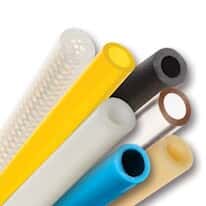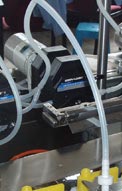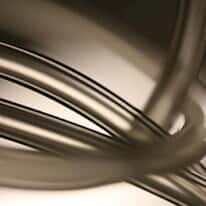The "STAMP" Tubing Selection Guide
The Easier Way to Select Pump Tubing: Just Use "STAMP"
A successful tubing choice results in a system that delivers optimal performance and prevents redesign and troubleshooting later. To make a well-considered selection for your application, just remember the acronym STAMP.
The information presented below is intended to serve as a guide for selection and specification of flexible tubing. Proper use of this guide will lead to easier design of fluid systems, optimal performance and a reduction in redesign and troubleshooting later in the project.
In choosing the right tubing for your application, there are several factors to consider, most of which are forgotten until it is too late. To make the process simple, use the acronym STAMP to help remember each factor.
Each letter refers to a critical component of the selection process: "size, temperature, application, media and pressure," but there is more detail for each letter, which is outlined in this guide.

S — size
There is always the ID, OD and wall to be considered with size, but cut lengths are also an important factor often forgotten. ID, OD and wall play a tremendous factor in pressure and vacuum ratings and must be considered in the decision. The tolerances are also a concern for leak points and critical dimensions of the design. Understanding the end users connection options will help assure a proper fit and elimination of problems later in the process.
T — temperature
Temperature has a wide variety of implications on the tubing selection process. Operating temperature is most often considered due to its obvious importance, but cleaning temperature, ambient temperature and the complete temperature fluctuation must also be considered. Sudden changes or extreme temperatures can negatively affect performance and cause premature failures. This normally results in a higher cost material as the only option, but with advances in manufacturing capabilities, exploring multi-layer products can help ease this cost while meeting the performance expectations.

A — application
Understanding the application is the most complex portion of the selection process and most often overlooked. End users can be vague with a description, either because they truly aren't sure what they are looking for in terms of tubing, or, they are worried about disclosing too much information about their break through product. Either way, getting answers will help both parties.
Regulatory concerns are always at the top of the list. Understanding what documentation is needed and special regulatory compliance is important. FDA, USDA, 3A, ISO, EPA, USP and NSF all carry different compliance concerns which will warrant different material selection. Proper supporting documentation and certificates should be reviewed before ordering with all details agreed upon before the first shipment arrives. Missing documentation will only delay the process and create unnecessary aggravation.
Knowing the dynamics of the application will assist with material selection for clarity, durometer (relative hardness), flexural fatigue or abrasion resistance and peristaltic pump use. There are materials available to combat each of these factors individually and multi-layer options to solve a mix of these factors. The first step is understanding the full scope of the application.
M — media
Understanding the fluid or media being transported is necessary to assure zero extractables, adsorption/absorption and particulate entrapment. Different chemicals attack various materials at different rates, so understanding the complete use of the product will help with proper selection. Cleaning agents are often the most aggressive fluids used, but you must also be aware of any chemical reactions which might be caused by changing fluids. Often overlooked is the ambient chemicals present in the atmosphere, either present in the air surrounding the tubing product or dripping by way of leaks or condensation creation. If the fluid is very aggressive, multi-layer products can be selected to assist with barrier protection and lessen the overall material cost.
Some materials can be produced at tighter tolerances for tighter fitting connections to avoid leak points, while others can be produced with a smoother inner surface for better flushing. Understanding the fluid being conveyed can help maximize the efficiency of your project to assist with easier flushing and avoidance of costly leaks. Safety also plays a role with material selection. Some requirements mandate viewing the fluid being conveyed. This means the material must have a sufficient level of clarity to see the fluid path and distinguish if any material is present. Other options require identifying marks for various chemicals through the use of colored tubing products or specific marking text. This can be accomplished and is a growing trend in efforts to further companies safety improvements. If this is of interest, make sure your manufacturer of choice can handle these types of options.

P — pressure
Vacuum and positive pressure create stress on any tubing product. Ignoring these factors can create hazardous conditions during product use. Increased or decreased temperatures greatly reduce the pressure rating for materials and proper measures must be taken. Changing the wall thickness can help increase pressure rating, as can reducing the overall OD/ID. If this isn't an option, multi-layer products of various materials can help handle the desired pressure as well as maintain the proper condition in the fluid path.
Pressures created during normal operation aren't the only conditions playing a factor when selecting the proper lab tubing. Cleaning cycles can create the most extreme pressure conditions and must be considered during the selection.
Summary
Overall, this "STAMP" guide is meant as a tool and turned into an acronym to make the process simpler. When selecting your product, as always, quality is of the utmost importance. Don't shy away from asking the manufacturer about their quality process, plant tours and seeing how your product is designed and produced. Should something ever go wrong in the field, you want to know your manufacturer partner has all the supporting quality documentation.